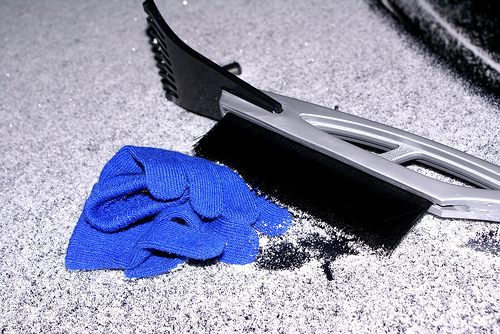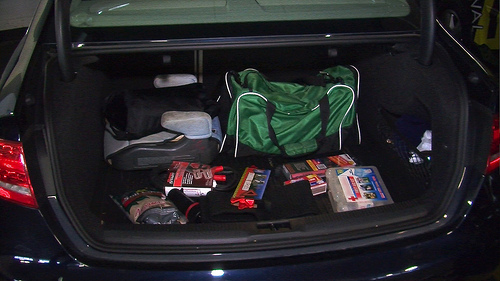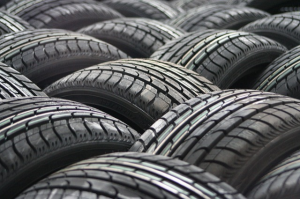Winter is here and that means nasty weather could make your travels a bit more slippery (no pun intended!) than usual. AccuWeather’s winter forecast is calling for above-normal snowfall in some parts of the country, and the Federal Highway Administration reports that nearly one-quarter of weather-related vehicle crashes occur on snowy, slushy or icy roads.

Whether your travel plans take you an hour away from home or onto international pavement, we urge you to stay safe this winter by following our road safety advice. First things first, in regions that don’t enjoy extremely mild and dry winters, don’t expect your vehicle to function properly for your trips without some extra TLC:
Battery
If your battery is more than four years old, have a certified repair shop test its ability to hold a charge. Granted, there are roadside assistance companies like AAA or NAC (or perhaps even a good samaritan!) to help you jump-start your vehicle in the middle of a blizzard, but wouldn’t you rather avoid a situation like this altogether? Hint: when you’re getting your battery checked, you might as well make sure the belts and hoses also get checked for wear and tear as cold weather can do a number on them.
Brakes
Slick roads can especially magnify brake system problems, so it’s important to have brakes inspected annually by a qualified technician–brake components that are badly worn, or a brake system in need of hydraulic fluid, may not provide the level of control needed for safe winter driving.
Defrosting and Heating Units
Get both of these units examined and you’ll stay warm, comfortable and fog-free all winter long. Heater coils can be expensive to replace, but will be well worth it to avoid shivering behind the wheel.
Emergency Road Kit
Despite the best preparations, sometimes an emergency strikes anyway. Making sure you have these items for your next winter road trip can go a long way:
- Bag of sand, salt or cat litter (for traction if you get stuck in snow)
- Battery-powered radio
- Blankets
- Booster cables, flares, tire pump
- Candles and matches
- Compasses and maps (don’t rely on your smartphone or GPS system in your car for emergency situations – anything can go wrong!)

- Driver’s License
- Emergency warning flares or triangles
- Flashlight and extra batteries
- Gloves or mittens
- Ice scraper and a snow brush
- International Driving Permit (IDP ) if you’re planning on driving abroad
- Nonperishable food items and extra water
- Plastic bags (for sanitation)
- Roadside Assistance Membership Card
- Travel Assistance Membership Card–if you get sick or hurt and need emergency medical assistance when you’re more than 50 miles away from home.
- Travel first-aid kit
For more information, download the CDC’s winter emergency kit checklist. If you’re renting a car in your destination, you can purchase many of these items when you arrive to avoid overloading your luggage.
Engine Coolant
Your car’s coolant system not only keeps your engine from overheating, but is also responsible for protecting your engine against corrosion. Aim for having a 50-50 ratio of antifreeze (coolant) and water inside your radiator. This will prevent the mixture from freezing even at outrageously cold temperatures.
Engine Oil
Make sure you have the proper oil for your region’s conditions (your owner’s manual is a good place to find this information).
Also, be sure you follow manufacturer recommendations regarding time between oil changes. Sometimes people forget to keep up with their oil changes in the winter.
Four Wheel Drive (4WD)
Check the status of your 4WD and make sure it’s working correctly–is it engaging and disengaging easily? Do all the drivers in your household know how to activate it? Reminder: having a 4WD system doesn’t mean you can speed around icy parking lots or drive 80 mph on the highway during a blizzard. 4WD can improve your traction on snow and ice from a stationary position, but it doesn’t make your tires grip the pavement any better when you break. Bottom line? 4WD does NOT make you invincible.
Tires
 Properly inflated tires means you’ll have the best possible traction when you’re forced to drive in wet, snowy or icy conditions. The air pressure in your tires has likely dropped as the weather has gotten colder– you can generally expect that you’ll lose 1 pound per square inch whenever the temperature drops by 10 degrees Fahrenheit.
Properly inflated tires means you’ll have the best possible traction when you’re forced to drive in wet, snowy or icy conditions. The air pressure in your tires has likely dropped as the weather has gotten colder– you can generally expect that you’ll lose 1 pound per square inch whenever the temperature drops by 10 degrees Fahrenheit.
Windshield Wipers
When was the last time you replaced your windshield wiper blades? They usually work effectively for about six months to one year, so you may be overdue. Also, for best results in clearing off cold, heavy grime, select a washer fluid with an antifreeze solution. But beware: some washer fluids can be harsh and damage your car’s paint– consult with an expert before buying.
Now that your vehicle is winterized and ready to go, next up: tips for driving safely in stormy weather. Stay tuned!


